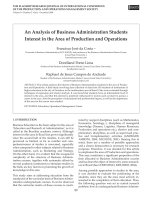Business development in licensed retailing (hospitality leisure and tourism)
Bạn đang xem bản rút gọn của tài liệu. Xem và tải ngay bản đầy đủ của tài liệu tại đây (2.83 MB, 347 trang )
Business Development in Licensed Retailing
This Page Intentionally Left Blank
Business Development in
Licensed Retailing
A unit manager’s guide
Conrad Lashley and Guy Lincoln
OXFORD AMSTERDAM BOSTON LONDON NEW YORK PARIS
SAN DIEGO SAN FRANCISCO SINGAPORE SYDNEY TOKYO
Butterworth-Heinemann
An imprint of Elsevier Science
Linacre House, Jordan Hill, Oxford OX2 8DP
225 Wildwood Avenue, Woburn MA 01801-2041
First published 2003
Copyright © 2003, Conrad Lashley and Guy Lincoln. All rights reserved
The right of Conrad Lashley and Guy Lincoln to be identified as the authors of
this work has been asserted in accordance with the Copyright, Designs and
Patents Act 1988
No part of this publication may be reproduced in any material form (including
photocopying or storing in any medium by electronic means and whether
or not transiently or incidentally to some other use of this publication) without
the written permission of the copyright holder except in accordance with the
provisions of the Copyright, Designs and Patents Act 1988 or under the terms of
a licence issued by the Copyright Licensing Agency Ltd, 90 Tottenham Court Road,
London, England W1T 4LP. Applications for the copyright holder’s written
permission to reproduce any part of this publication should be addressed
to the publisher
British Library Cataloguing in Publication Data
A catalogue record for this book is available from the British Library
Library of Congress Cataloguing in Publication Data
A catalogue record for this book is available from the Library of Congress
ISBN 0 7506 5334 5
For information on all Butterworth-Heinemann publications
visit our website at www.bh.com
Composition by Genesis Typesetting, Rochester, Kent
Printed and bound in Great Britain
Contents
ix
xi
xv
xvii
1
What business are you in?
Bar and pub services management
The downside of licensed retail branding!
About services . . .
Working with customers
About hospitality
1
2
6
9
19
21
2
Looking for more than breath on the mirror in recruitment
Recruiting and selecting staff for effective service
Flexible employees
The local market for labour
The importance of planning ahead
Describing the job to be done
Describing the ideal recruit
Attracting candidates
Making the selection
Approaches to recruitment and selection
24
25
25
26
28
29
30
32
38
43
3
It takes happy workers to make happy customers
Team leadership and motivation
What kind of leader?
A matter of choice?
Working in teams
Benefits of working in teams
48
49
50
63
65
67
4
It’s people, people, people
Working with people
Individual differences
70
71
71
v
Hospitality, Leisure & Tourism Series
Foreword
Preface
List of figures
List of tables
Contents
Hospitality, Leisure & Tourism Series
Individuals in groups
Influencing others
Dealing with conflict
Motivating people at work
vi
83
85
87
92
5
Now you see them, now you don’t
Staff retention and turnover in licensed retailing
Causes and types of staff turnover
Counting the cost
Measuring staff turnover
Wasted millions: some industry examples
Keeping your staff – it’s not rocket science! Everyone can do it!
96
97
97
101
104
108
108
6
Training improves business performance
Employee training and development
The benefits of training
Training your staff
The ABC of training
119
120
120
127
133
7
Serve hot food hot, and cold drinks cold, and everybody smiles
Managing service quality
Licensed retail service quality
Quality management and licensed retail operations
137
138
138
146
8
Get it hot to the table on time
Managing food operations
Food operations in licensed retailing
Managing key points of control
154
155
155
165
9
On turning a profit
Financial control in licensed retailing
The principles of control
Financial targets and business performance
Identify and understand cost and sales data
Analysing the financial data
Analysis of cost–volume–profit data
177
178
178
180
182
187
192
10
On turning more profit
Further financial controls to improve business performance
Profit sensitivity analysis
Reviewing sales patterns
Menu engineering
Budgets
198
199
199
204
207
213
11
There’s more to it than cutting wages
Labour cost management
Elements of labour costs
Measuring staff costs
Adding to staff income
Scheduling employees
221
222
222
230
233
236
Contents
12
Meeting and exceeding customer expectations
Marketing – understanding your market
A customer focus
Segmentation
Customer occasions
Capturing information
241
242
243
244
248
258
13
Let’s keep in touch
Marketing – promoting your business
Understanding the competitors
Understanding the local community
The SWOT analysis
What is promotion?
262
263
263
263
265
269
14
Improving the chance of reaching your destination
Preparing a unit business plan
Describing the business
Competitive business strategy
Operations
Forecasting results
Writing up, presenting and working with your business plan
Working with the business plan
285
286
286
294
296
297
298
302
15
Seeing the wood for the trees – case study
Silverwood Pub Company
The immediate situation
The immediate incident
304
305
307
310
315
Hospitality, Leisure & Tourism Series
Index
vii
This Page Intentionally Left Blank
JD Wetherspoon Plc operates almost 600 pubs throughout the United Kingdom. It is
the fastest growing company in the UK and the ninth fastest in Europe.
The company has created more than 10,000 jobs in its pubs and head office during
the past four years and aims to create an additional 3000 jobs each year for the next
ten years.
It is vitally important to our business that all of our outlets consistently offer the
highest standards of service and customer at all times.
Our managers and associates who serve the customers on a day-to-day basis are
essential in ensuring that Wetherspoon continues to build a loyal customer base and
to grow the business on a year-by-year basis.
The company’s overall performance is dependent on the quality and effectiveness
of all our employees in every one of the pubs.
Management and staff training has always been, and continues to be, a main
priority for the company.
It therefore gives me great pleasure to write the Foreword to this book by Conrad
Lashley and Guy Lincoln.
It is my opinion that Business Development in Licensed Retailing will be a valuable
reference for any management development programme.
The book has been written and organized in a manner that explains all of the
underlying management principles involved in running a busy and successful
licensed operation.
At the same time it gives a wide range of practical examples and guidance on how
to achieve success.
These principles of effective recruitment, induction, training, leadership and
retention are at the heart of Wetherspoon and provide the foundations for the
service, quality and consistency to all our customers.
Tim Martin, Chairman – JD Wetherspoon
ix
Hospitality, Leisure & Tourism Series
Foreword
This Page Intentionally Left Blank
The licensed retail sector is undergoing dramatic change. The impact of attempts to
increase competition by limiting the number of licensed outlets that any one firm can
directly manage has been profound. Since the late 1980s, the major brewers have had
to refocus their operations. They have been forced to divest most of their direct
holdings of pub and bar outlets, and those few firms still in the brewing business
now concentrate on the direct management of high volume, branded properties that
have much in common with traditional retail units. As a direct consequence of
divestment by the major brewers, a significant number of large non-brewing pub
retailers have entered the marketplace. The skills needed to run these businesses are
increasingly similar to those required of more traditional retailers. Each unit is
frequently a significant business in its own right.
This book focuses on the key skills needed to manage bar, pub and restaurant
units, irrespective of whether the business is largely ‘wet’ or largely ‘dry’. We
recognize that the boundary between pubs and restaurants is becoming increasingly
blurred. Many pubs and bars that are chiefly places where people go to drink have
significant food sales. In other cases, what might be considered ‘restaurants’ now
encourage customers to buy drinks before and after their meals. In reality these
distinctions are less relevant to unit managers than understanding who the
customers are and why they are using the establishment. Thus we use examples of
businesses that combine food and drink sales in multi-unit locations. The skills
needed at unit level are similar, irrespective of the balance of food and drink sales in
the business.
Flowing from this, to illustrate our points we use examples from best practice in
retailing. These are not always traditional bar and pub locations, but the point is that
the sector can learn from professional approaches in sectors that are similar. In
particular we use examples from J.D. Wetherspoons, Harvester Restaurants, TGI
Fridays and, occasionally, McDonald’s Restaurants, because these provide examples
of management practice that could be adopted by the licensed retail sector. In the
first case the company is chiefly ‘wet’ led but also has a significant food business; in
the second and third cases, both companies have a considerable minority of total
sales arising from the sale of drinks. In the case of the fast-food operator, the
company’s professional approach to brand management, monitoring business
performance and commitment to service quality management provides an example
that could benefit many licensed retailers.
xi
Hospitality, Leisure & Tourism Series
Preface
Preface
Hospitality, Leisure & Tourism Series
The unit manager and the staff directly involved with customers have a particular
significance in delivering customer satisfaction. Satisfied customers are much more
likely to return, and building a strong base of loyal customers is a key source of
competitive advantage, leading ultimately to sales and profit growth. Although
many licensed retail organizations express these sentiments in official documents
and in public pronouncements, detailed investigation of what they actually do in
practice reveals this as a somewhat rhetorical set of claims. Many are guilty of
claiming that people are their most important asset, yet treating them as a cost to be
minimized.
At this stage, many British mangers are still developing their understanding of
what is needed to manage bars, pubs and restaurants, but one emerging shared truth
is that the unit manager is key to the success of each business unit. The performance
of the restaurant, bar or pub is most fundamentally influenced by the skills, talents,
priorities and personality of the immediate unit manager. Studies comparing
different levels of profitability, sales, staff turnover, customer satisfaction and
employee satisfaction in different units in the same group show how important the
performance of the unit manager is to the success of the unit. Indeed, industrial
experience in many licensed retail organizations shows that a change of managers in
the same unit can result in dramatic changes in the unit’s business performance.
This book aims to provide a resource for both unit management programmes in
licensed retail organizations and for academics preparing students for careers in
licensed retail management. It is deliberately written in a way that addresses a ‘how
to do agenda’ by offering a practical guide to the skills and knowledge needed by
those who will be managing bars, restaurants and pubs in fast-moving licensed
retailing contexts. The book is deliberately presented in a non-academic style,
without the referencing and quotations typical of academic texts. Within a higher
education context, it is assumed that the book will be largely used at Level Two in
programmes of study. Traditionally, this stage of hospitality, leisure and tourism
management programmes focuses on the practical techniques involved in managing
operations. Similarly, the book is written in a way that goes beyond the simple
checklist of many distance-learning materials found in in-company management
development programmes.
At root, the book assumes that managers running what are substantial businesses in
their own right need to be ‘reflective practitioners’. The very nature of the task-driven
practical immediacy of their work means that they have to be capable of active
management and practical solutions to unit management situations. That said, they
also need to be capable of standing back and reflecting on their actions so as to be more
effective in future. The problem is that many unit managers in hospitality retail
operations are by inclination ‘Activist’ learners (Honey and Mumford, 1986) – that is,
they are mostly people who are comfortable in action and ‘sorting things out’, but less
so with standing back and thinking about what they are doing and why. We recently
came across a pub manager who had recruited 287 people in a six-month period – the
normal establishment was fifty employees. He was recruiting over ten new staff every
week. Indeed, the replacement of staff dominated his work for that period. Instead of
spending time developing sales, addressing customer satisfaction and increasing
profits, he was almost permanently engaged in recruitment. Had he stood back and
reflected on the situation, he might have come up with some more useful ways of
spending his time. This case is not untypical; many managers feel comfortable
keeping busy, and spend little time in active self-critical reflection.
xii
Given the learning needs of both current and would-be managers, the text
attempts to combine theoretical concepts and practical advice in a way that uses
theory as a tool but is not overly theoretical. Where appropriate, the text is illustrated
by examples from different licensed retail operations. In the main, these are set
within a context that assumes that hospitality retail operations are not all the same.
Using a model developed with Steven Taylor (Lashley and Taylor, 1998), we suggest
that there are three types of licensed retail offers to customers; uniformity
dependent, choice dependent and relationship dependent. Each of these offers
involves a different set of customer expectations, critical success factors, definitions
of service quality and requirements for frontline staff performance. Hence this text
assumes that there is no one best way of managing hospitality retail units, but there
is likely to be a match between the offer to the customer and the way service
employees are managed.
Finally, the content of the book is informed by research with a number of key
licensed retail operators. It is much closer to a programme of manager training and
development in industry than a traditional single-disciplined book. Hence the
content asks, what does a manager of one of these units need to know? It therefore
contains a number of key themes that are rarely found in one text.
Given that managers of licensed retail organizations have little strategic control
over marketing, people or financial matters, the text focuses on providing an
understanding of these matters and showing how they shape the manager’s
immediate tactical role. Fundamentally, the manager has to understand that people
are the key asset of the business, and a large part of the book focuses on
understanding and working with people. Understanding what makes them tick,
team leadership, successful recruitment and staff training are all essential in
controlling the hidden cost of staff turnover. Traditionally, many of these businesses
have been happy to live with levels of staff turnover that mean each job is filled
twice or three times per year. Apart from the high direct costs to the business, high
staff turnover creates barriers to building customer loyalty and competitive
advantage through quality service delivery.
A second key theme in the book explores the nature of service difference and
different offers made to customers, together with the implications this has for service
quality and service quality management. In addition to the variations in key service
offers discussed above, customers use a variety of licensed retail operations on
different occasions. The same customer may have different expectations of the
products and services within the same bar or restaurant depending on the ‘occasion’
of the visit. Unit managers need to have a thorough understanding of service quality
management and the critical success factors that will shape customer assessment of
quality of the visit.
Thirdly, the book explores a number of issues associated with managing the unit
as a commercial venture. At an immediate tactical level, managers need to
understand how to manage their own time effectively and how to ensure that other
team members are working towards the various aims and objectives set. The
business planning process is therefore a core aspect of effective unit operation. It is
through this device that team member efforts are directed towards global goals to
manage costs and ensure that revenue exceeds expenditure and generates profits for
the organization. Within the framework the book argues for and demonstrates an
alternative approach to managing people compared with traditional management
approaches in the field. The approach takes for granted that people are the key asset
xiii
Hospitality, Leisure & Tourism Series
Preface
Preface
in delivering improved business performance and shows that an investment in
people through improved salaries and training budgets can boost the bottom-line
performance of the business.
Further reading
Honey, P. and Mumford, A. (1986). Manual of Learning Styles. BBC Books.
Lashley, C. and Taylor, S. (1998). Hospitality retail operations types and styles in the
management of human resources. J. Retail. Cons. Serv., 5(3).
Conrad Lashley
Professor of Hospitality Retailing
Leeds Metropolitan University
Hospitality, Leisure & Tourism Series
Guy Lincoln
Senior Lecturer in Licensed Retailing
Leeds Metropolitan University
xiv
Figures
1.1
1.2
1.3
1.4
1.5
1.6
Typical pub customer service needs
Tangible and intangible elements of customer service for a bar
Continuum of product and service benefits
Continuum of predictable and personal service benefits
Licensed retail service types
Functional interdependence of service management
Figure 2.1
Figure 2.2
Figure 2.3
A display advertisement for licensed retail staff
A classified advertisement for licensed retail staff
A semi-display advertisement for licensed retail staff
Figure 3.1
Figure 3.2
Time spent in different ego states at work and at home
The managerial grid
Figure
Figure
Figure
Figure
Figure
Figure
Figure
Figure
Figure
4.1
4.2
4.3
4.4
4.5
4.6
4.7
4.8
4.9
Personality profiles
Dimensions of extroversion/introversion
Dimensions of stability/instability
Interpreting information
Differing perceptions
Seeing things in context
Say what you see
Control conflicts in the service encounter
Strategies for handling conflict
Figure
Figure
Figure
Figure
5.1
5.2
5.3
5.4
The vicious cycle of staff turnover
National estimates of staff turnover costs (£)
Example of a survival curve
The virtuous cycle of staff turnover
Figure 6.1
Proficiency and time taken to reach optimum work output
Figure 7.1
Customer satisfaction and employee satisfaction
Figure 8.1
Figure 8.2
Stages in the control process for food and drink
Food operation in a licensed retail unit
Figure 9.1
Figure 9.2
The control cycle
Different types of costs in licensed retailing
Hospitality, Leisure & Tourism Series
Figure
Figure
Figure
Figure
Figure
Figure
xv
Hospitality, Leisure & Tourism Series
List of figures
xvi
Figure 10.1
Figure 10.2
Menu engineering classification of items
The budget cycle
Figure 11.1
Figure 11.2
Figure 11.3
Total labour costs
Number of customers served per day
Sample hourly schedule for pub staff
Figure 12.1
Customer categories
Figure 13.1
Figure 13.2
Figure 13.3
Developing promotional activity
The AIDA model
The promotions mix
Figure 14.1
The pyramid of goals
Tables
1.1
1.2
1.3
1.4
A selection of major licensed retail brands as at May 2001
Some brand features of a sample of licensed retail brands
Customer contact with service staff at The Dog and Duck
Examples of customer occasions in licensed retailing
Table 2.1
Table 2.2
Table 2.3
Example of a job description for a Kitchen Assistant
Staff specification for a Kitchen Assistant
Example of a short-listing matrix for a Kitchen Assistant
Table
Table
Table
Table
Table
Table
Table
Table
Table
Table
Table
Sources of job satisfaction
Gauging sociability
Benefits and limitations of distance and closeness
Disadvantages of constant ego states in managers
Management priorities
Priorities – technical/tasks, or people
A question of balance
Making decisions
Mapping decision-making styles
Benefits and limitations of decision-making styles
Sources of job satisfaction
3.1
3.2
3.3
3.4
3.5
3.6
3.7
3.8
3.9
3.10
3.11
Table 4.1
Table 4.2
For extreme personality profiles
Scoring key for Exercise 4.1
Table
Table
Table
Table
Some push and pull factors in staff turnover
Some voluntary and involuntary forms of staff turnover
Some direct and hidden costs of staff turnover
Levels and costs of staff turnover in thirty licensed retail organizations
5.1
5.2
5.3
5.4
Table 6.1
Table 6.2
Benefits of training
Comparison of trained and untrained employees in a bar
Table
Table
Table
Table
The quality characteristics matrix
The five dimensions of service
Positive and negative responses to critical service incidents
Principles of total quality management
7.1
7.2
7.3
7.4
Table 8.1
Systems model
xvii
Hospitality, Leisure & Tourism Series
Table
Table
Table
Table
List of tables
Table 9.1
Table 9.2
Table 9.3
The monetary and non-monetary measures of sales
Example operating profit and loss statement for the Dog and Duck
Profit and loss report for the Big Six
Table
Table
Table
Table
Table
Table
Table
Table
10.1
10.2
10.3
10.4
10.5
10.6
10.7
10.8
Sales and cost figures for sales mix analysis – original performance
Sales and cost figures for sales mix analysis – change in performance
Example weekly sales figures by period
Average spend brand comparison
Daily breakdown of sales
Yearly planning review of sales
Menu engineering data record sheet
Input into the setting of budget targets
Table
Table
Table
Table
Table
Table
11.1
11.2
11.3
11.4
11.5
11.6
Staff turnover in a sample of McDonald’s restaurants
Employee performance indicators
Labour performance indicators for the Leeds and Nottingham pubs
Comparison of experienced versus inexperienced staff
Hourly business volumes in the pub
Staffing needs in the pub
Table
Table
Table
Table
12.1
12.2
12.3
12.4
Relevance: myths and realities
Overview of segmentation variables – personal characteristics
Key attributes of the offer – Rat & Parrot
Collecting information
Table
Table
Table
Table
Table
Table
13.1
13.2
13.3
13.4
13.5
13.6
Table
Table
Table
Table
14.1
14.2
14.3
14.4
Product and service analysis
Competitor analysis
Extract from gross profit budget for The Wise Owl, Chelmsford
Extract from gross profit budget for The Wise Owl, Chelmsford
Table
Table
Table
Table
Table
Table
15.1
15.2
15.3
15.4
15.5
15.6
The twelve restaurants at the time of the incident
Pub sales information
Training in the pubs
Staff turnover in the pubs
External customer satisfaction ratings
Employee satisfaction survey results (expressed as a percentage)
Hospitality, Leisure & Tourism Series
Unit and competitor evaluation form
Suggested local community audit form
Suggested local environment audit
Suggested SWOT analysis and action priorities
Steps toward purchase
Comparison of promotional tools available for branded licensed retail
units
Table 13.7 Informal evaluation
xviii
C H A P T E R
•
•
•
•
1
What business
are you in?
Learning objectives
After working through this chapter, you should be
able to:
᭹
highlight the key features of licensed retail service
᭹
identify different types of licensed service
operations
᭹
explain the key drivers of licensed services types
᭹
contrast and compare service management
techniques.
Business Development in Licensed Retailing
Bar and pub services management
In the past, many people thought that the key to successful pub business was
‘location, location, location’ – in other words, the location of the pub or bar was the
most important factor in determining its success. However, there are many
successful bars and pubs that are in poor locations yet still manage to build sales
and good profits. It’s not so much where your pub or bar is located, but what goes on
inside it – in particular, how the landlord and staff deal with customers.
This chapter aims to show that although licensed retail services are different,
customers expect the quality of product and services to match their expectations.
Good unit management understands what customers want, and recognizes that
employees – their selection, training, motivation, reward and management – are key
to customer satisfaction.
Licensed retail services
Hospitality, Leisure & Tourism Series
Licensed retail organizations provide drink and/or food and/or accommodation in
a service context. In most cases, these services are both produced and consumed on
the premises. In the case of the ‘off trade’, the product is consumed away from the
premises in a manner much closer to general retail services. Whilst reference will be
made to the off-licence dimensions of the business, this book is largely concerned
with the management of on-site licensed retailing because these businesses are more
complex and involve a more detailed service transaction than simply retail. It is
important to recognize that bars, pubs and restaurants offer services that have a
deep-seated meaning to customers that touch on the domestic and cultural
meanings of hospitality. These meanings will be briefly touched on later in the
chapter, but the host and guest relationship, where the licensee/landlord is in effect
inviting customers into his or her home, is an important element of the service being
provided.
This book is aimed at licensed retail operations where bars or pubs are directly
managed as part of a chain. Licensed retailing involves an increasing focus of bar
and pub services on brands that make a clear offer to an identified profile or segment
of customers and the occasions on which they use pub and bar services. Whilst much
of the book applies to the management of all bars and pubs, and can be applied both
in the free house and in the ‘tied trade’, the book is specifically concerned with
identifying issues associated with licensed retail units that are managed as part of a
chain (Table 1.1).
Licensed retail organizations that operate through chains provide these services in
a way that is increasingly:
1 Branded: services are usually sold under a brand name, traditionally a brewery or
beer brand. Brands are chains of bar, caf´e and pub outlets that trade under the
same name. The brand may represent a cluster of attributes or benefits to
customers, who have an idea of what to expect when entering the premises.
Traditionally this was the brewery beer brand, although increasingly brands are
trading names that shape customer expectations and cluster round similar service
offers.
2 Customer focused: a consequence of branding is to shape the nature of the products
and services that make up the brand to particular customer types, needs and
2
What business are you in?
Brand name
Licensed retail
service
Number
of units
Owner
corporation
Main service
predominance
J.D. Wetherspoons
Pubs with significant
food offer
500
J.D. Wetherspoons
Wet led
Chef & Brewer
Pub and restaurant
service
95
Scottish &
Newcastle Retail
Food led
TGI Fridays (UK)
American restaurant
and cocktail bar
40
Whitbread
Restaurants
Food led
Harvester
Restaurants
Traditional
restaurant and pub
130
Bass Leisure
Retail
Food led
John Barras
Community pub and
restaurant
155
Scottish &
Newcastle Retail
Wet led
Brewers Fayre
Pub and restaurant
services
273
Whitbread
Restaurants
Food led
Brewsters
Pub and restaurant
services
120
Whitbread
Restaurants
Food led
All Bar One
Cosmopolitan bars
serving food
54
Bass Leisure
Retail
Wet led
3
4
5
6
experiences. Issues such as age, gender, social class, income, region, family and
lifecycle, consumption patterns and service needs help retailers to focus the brand
and the messages required by customers.
Standardized: though this will vary according to the nature of the brand and
business, standardization follows from the requirement of customers for consistency and predictability. Typically, the range of food and drink items, the prices
charged, decor and building layout are standardized across all units.
Consistent in quality: management of the experience has to be concerned with
ensuring that customers get the experience they expect. That is, not only the
physical products but also the type of service they get from staff must be
consistent and in line with customer expectations. Thus service quality, staff
training and performance appraisal become important tools in unit
management.
Managed via operating systems: consistency and standardization across hundreds of
units frequently require that all operate to a centrally designed system that guides
the way in which products are purchased, assembled and served. In many cases
these systems also lay down how training, recruitment and other staff management issues are to be handled.
Sales driven: using techniques from the retail goods sector, licensed retail
businesses are concerned to ensure that communication with customers is clear.
The nature of the product and services on offer are stated in a way that allows
minimal confusion and misunderstanding. Point-of-sale material and staff
3
Hospitality, Leisure & Tourism Series
Table 1.1 A selection of major licensed retail brands as at May 2001 (source: Martin Information Guide to Pub, Bar
& Nightclub Brands (2001)
Business Development in Licensed Retailing
training in ‘up-selling’ techniques, together with an array of other techniques,
attempt to maximize the sale to each customer.
7 Mass marketed: to generate customer identification and to shape clear communications with customers, licensed retailing organizations increasingly use mass
advertising through television and newspapers, as well as other promotional
techniques, to inform customers about the brand and services on offer.
8 Location defined: these managed pubs and bars have a distinct set of location
characteristics that define their typical size and high street, suburban or trunk
road locations, property types, age characteristics, parking facilities, or proximity
to transport links, etc.
Hospitality, Leisure & Tourism Series
Table 1.2 illustrates some brand features of a sample of licensed brands.
Brand
Style/target
customer
Ideal sites
Locations
J.D. Wetherspoons
Traditional basic pub,
no frills style, but food
growing in importance
Empty buildings, not
usually pubs, in good
positions; 5 500 sq ft
Nationwide from
London origins,
most major cities
Chef & Brewer
More up-market pub
restaurants; a long
established brand
Minimum 3 000 sq ft
front house,
1 750 sq ft back
Suburban, country
and ‘city village’
sites
TGI Fridays (UK)
Licensed from USA;
smaller units (200
seats) being
developed; some next
to Travel Inn
7 000 sq ft
Early, city centre
sites; now more
major roads and
suburban
Harvester
Restaurants
Country farmhousestyle eating places;
casual family dining
Off major motorways
and roadside sites
Mostly located in
South East and
Midlands
John Barras
Victorian-style
community pubs
On main road and
community sites
Most located in
Northern England
Brewers Fayre
Pub restaurant aimed
at the adult market
Out of town, 1–3
acre sites by towns
with 50 000+
population
Suburban, within
short distance of
motorways
Brewsters
Pub restaurant aimed
at the family market;
some re-branded
from Brewers Fayre
Out of town, 1–3
acre sites by towns
with 50 000+
population
Suburban, within
short distance of
motorways
All Bar One
Cosmopolitan bars,
quality food and
restaurant-style
service
High street locations,
vary in size
Affluent urban
areas, major cities
Table 1.2 Some brand features of a sample of licensed retail brands
4
What business are you in?
Over the past few decades, branded licensed retail services have taken an
increasing share of bar, caf´e, restaurant and hotel business in the UK and other
western countries. The consistency of service, lower costs through the scale of their
operations, and appeal of a variety of brands to target markets have ensured wide
success.
As a unit manager working in one of these branded businesses you are required
to understand the nature of the brand in which you are working – that is, what is it
that customers are buying into? With this understanding you are able to focus on
customer expectations and what has to be done to ensure that customer expectations
are met.
Most importantly, as a unit manager in branded business you are required to
understand and work within the disciplines of the brand. Customers who
experience different facilities, prices, quality and service in different establishments
in the same brand will become confused about what the brand represents. Their
expectations become less clear and more uncertain, and a likely consequence is that
they will seek out a competitor who is more consistent.
Active learning point
In the table below, fill in the details of a bar brand known to you.
Brand
Comments
Brand name/owner/number of
outlets/geographical location
Food/drink/accommodation offer
Number of products/price
Service attributes/quality/
positioning/the service experience
Hospitality, Leisure & Tourism Series
Staffing/types/numbers/contact with
customers
Evidence of product/service consistency
Marketing and sales drives/pricing and
promotional strategies
Description of typical customers – age,
gender, income group, consumption
patterns, service needs
5
Business Development in Licensed Retailing
The downside of licensed retail branding!
Whilst these branded services have been very successful in capturing an increased
share of licensed retail service business, they face some difficult management issues.
Many of the features of these operations that have brought about their success also
lead to problems, and hence the need for this book.
Management skills • • •
In the past, successful management in the pub business was often defined as about
being ‘a nice couple who keep a good pint’. In other words, being a welcoming and
friendly host and maintaining good product quality standards were deemed to be
key determinants of success. Nowadays the high-volume businesses that are directly
managed in brand formats require different skills. The tightly defined brand
supported by operating systems, quality management techniques and policies
derived at Head Office can lead organizations to adopt a ‘command and control’
style that allows little scope for individual manager or employee initiative.
Managers at unit level are expected to work to the ‘one best way’. As we shall see,
for some businesses this is consistent with the offer to customers, but sometimes it
creates unnecessary difficulties because you may feel stifled and discouraged from
being creative in your work.
This book shows that there are a number of ways in which your skills as a unit
manager can be tapped and developed to the benefit of the brand.
Employee dissatisfaction • • •
Hospitality, Leisure & Tourism Series
The operating systems, tight product specification and ‘one best way’ job design
allow little scope for individual flair and creativity. Employees experience jobs that
are tightly controlled, routine and monotonous. On top of this, the uneven pace of
work in many bar and pub services, together with the difficulties inherent in serving
customers, add extra stress to licensed retail service work. Consequently, many
licensed retail operations face high labour turnover. It is not unusual for licensed
retailers to experience average labour turnover of over 150 per cent per year across
the whole brand, with some jobs and units recording labour turnover of over 500 per
cent per year. Apart from the direct costs of replacing staff – which can be
considerable in themselves – you as the manager will face difficulties through the
sheer volume of recruitment, selection, and training that you have to undertake.
Service inconsistencies • • •
Problems with service consistency can occur for several reasons. First, the very scale
of these organizations means that they are attempting to deliver consistent customer
experiences through a very large number of units. Hundreds of unit management
personnel and thousands of staff must all share an understanding of the brand, and
be prepared to work within the rigidities of operating procedures. With so many
people involved, there are clearly many opportunities for things to go wrong.
The second problem relates to the labour turnover. When there is a high rate of
labour turnover, a constant stream of new employees are joining and leaving the
organization. In these circumstances, it is difficult to communicate and train
employees to the desired standards.
6









